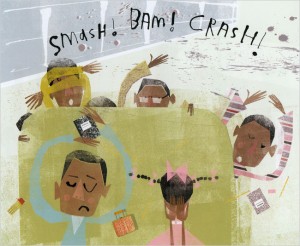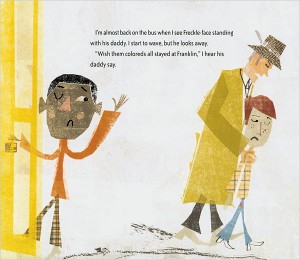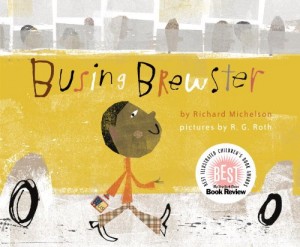By Phoebe Vreeland, The Children’s Book Review
Published: January 10, 2010
by Richard Michelson (Author), R. G. Roth (Illustrator)
Reading level: Ages 6-10
Hardcover: 32 pages
Publisher: Knopf Books for Young Readers (May 11, 2010)
Source: Publisher
Busing Brewster is a book about believing in one’s self, making friends across the barriers of race and the power of strong women in the lives of children—all themes that author Richard Michelson has written about before. The subject of this recent book is desegregation busing in Boston during the 1970’s. Michelson says he doesn’t aim at a particular reader, but relies upon the publisher to tell him what age his books are geared to. Knopf has targeted this book at ages 6-10, proving that, even after children have learned to read, picture books are still relevant. Michelson is a great believer in the value of visual literacy and a true spokesperson for picture books. He considers book illustrations fine art and his art gallery in Northampton, Massachusetts recently hosted the 21st Annual Children’s Illustration Show.
As a child growing up in a fairly poor Brooklyn neighborhood, racial issues were important to Michelson and have stayed near to his heart. His 2006, book Across the Alley tells of a friendship between a Jewish boy and his African-American neighbor. In 2008, his book, As Good as Anybody, about the friendship between Martin Luther King, Jr. and Abraham Joshua Heschel—a Polish rabbi who joined the Selma march—received starred reviews and won the Sydney Taylor Award Gold Medal.
Busing Brewster is told from the perspective of a six year-old boy who, along with his older brother Bryan, will be bused to an all white school an hour away. From the first page, Brewster’s challenges and support are neatly presented. The chain link fence he must scale to enter the playground is juxtaposed against the arms of his brother Bryan who reaches to catch him. The elements of family, community and familiarity are crucial. Thankfully, Brewster flies beneath the radar of racism somewhat, protected by his age, his brother, and the fact that he can’t read yet. His mother views busing as an opportunity to support the potential she sees in her sons and is encouraged by Central’s facilities: a proper library, art and music classes and a swimming pool. Brewster is buoyed up by his mother’s optimism and goes to bed with anticipation. His brother Bryan goes to bed beating his pillow, dreading rising early for the long bus ride and confronting the discrimination.
The next day, their bus is greeted by picketing adults and unwelcoming school children. Brewster takes a drink from the fountain, a boy shoves him and a fight ensues when Bryan intervenes. All three boys are sent to the library for a day of detention. They soon befriend a white boy whom they call Freckle-face. We see young Brewster’s ability to find similitude. Freckle-face’s laugh reminds him of neighborhood friend Big Earl. He imagines the librarian Miss O’Grady looks just like Miss Evelyn, the first grade teacher he would have had at Franklin, because they both wear glasses. Brewster sits, listening intently, as Miss O’Grady reads a book about the challenges Kennedy faced as an Irish Catholic. The story ends with Brewster returning home to tell his mother, “Someday I’m going to be president.” His optimism garners more meaning with the author’s note on the book’s last page: Michelson notes that the book was written in 2003, five years before Barak Obama’s election. It concludes with a wonderful quote circa 2005 from the then Senator Obama on the importance that libraries and reading play in a child’s development.
In most cases, the publisher selects the illustrator and someone at Knopf deserves kudos for a winning match. R.G. Roth is a clear departure from illustrators that Michelson has previously worked with—like E.B. Lewis and Raul Colon both who fleshed out his characters in watercolor realism. R.G. Roth’s illustrations last brought the appropriate mid-century feel to Karen Ehrhardt’s This Jazz Man, a sing-a-long tribute to nine great jazz musicians.
In Busing Brewster, Roth’s jaunty ink, watercolor and collage illustrations set Brewster’s optimistic tone. A pallet of mustard, burnt orange, avocado—complemented by a full range of flesh tones—establish the right retro feel. Collage fabric used for clothes is also vintage 70’s. Mama’s paisley head scarf and Miss O’Grady’s pink blouse stand out in contrasting softness to all the plaids and stripes. The characters are animated by curvy arms and legs that sport bell bottoms and tulip sleeves. The effect sets the pages in motion as the arches create a wave like undulation through the illustration. Roth has also used circles to great effect: the long arms of Mama’s embrace and the beautiful pink circle that Miss O’Grady’s arms form as she reads to the boys.

In true cartoon style, there is a scattering of hand-written sound effects. “Smash! Bam! Crash!” as a window shatters. Roth’s composition throughout the book is stunning. On a double page spread featuring the interior of the bus when a picketer’s rock shatters the window, the violent action is tempered by the graceful choreography of the children’s reaction. Bryan’s protective arms reach to shield Brewster.
Roth has even managed to use one technique with opposing effects: fragments of words on picket signs seem to diminish their power. Yet, on the library bookshelves the word fragments become powerful and offer a panorama into the world of possibility. Details like Jules’ peace sign yoyo and Brewster’s tiny lunch box, which features a bit of the American flag and the words US, also pack great import. The entire book is flawlessly designed with its retro feel, right down to the faux library due date stamped in red ink on the end papers.

It may be easy to get lost in the perfection of the artwork, but Michelson’s story is exquisitely crafted. The book offers a lesson in history through a window back to a time of challenge, all the while serving up timeless lessons. The story shows how children temper their feelings when others are watching—coping mechanisms that provide them resilience in the adult world: Brewster’s reaction to Mama’s hug, Brewster differs when Bryan is around and Freckle-face ignores his new friends when his racist father is present. We are reminded of the importance of loving and supportive adults to help children inculcate a belief in themselves and the value of strong communities. The book encourages one to look for sameness, not difference, as Brewster does.
May Brewster’s uplifting image become a new symbol of hope and a reminder of the potential in every child.
Add this book to your collection: Busing Brewster
Have you read this book? Rate it:
[ratings]
Visit: https://www.rmichelson.com/

